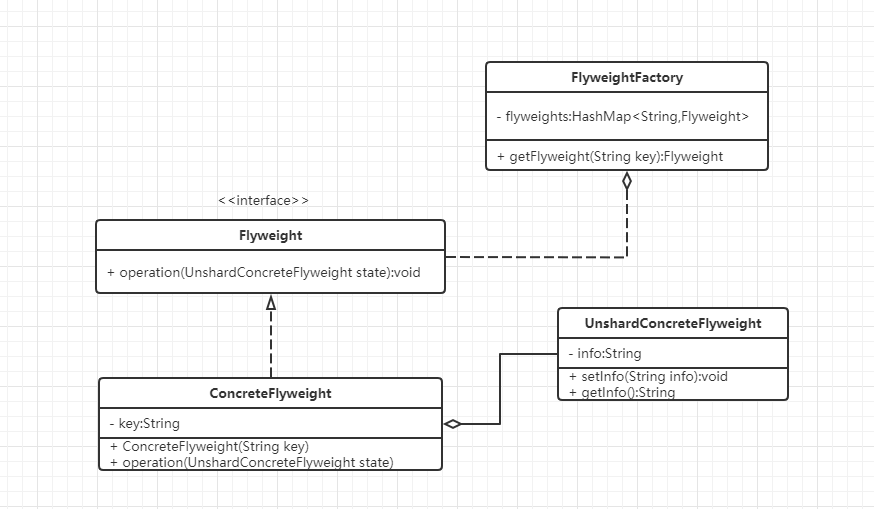设计模式-享元模式
享元模式
定义:使用共享物件,来减少内存使用量。通常物件中的部分状态时可以分享的,常见的做法时将他们放在外部数据结构中,当需要使用时再将它们传递给享元。能够避免重复创建。
应用实例:Java里的String字符串缓存池。数据库的数据池
使用场景:系统里有大量相似对象,需要用到缓存的场景
需要注意线程安全问题。
结构:
- Flyweight 抽象享元角色
- ConcreteFlyweight 具体享元角色
- UnsharedConcreteFlyweight 非享元角色
- FlyweightFactory 享元工厂角色
客户角色可以通过享元工厂去获取具体的享元对象,并调用相关方法。

示例场景:五子棋中的应用。我们都知道五子棋中包含了大量的“黑棋”和“白棋”,而这些棋子是可以复用的,而下棋的坐标是每次都不一样,属于非享元角色。
代码示例:
public interface ChessPieces {
void downPieces(PiecePoint piecePoint);
}
public class ConcreteChessPieces implements ChessPieces {
private String color;
public ConcreteChessPieces(String color) {
this.color = color;
}
@Override
public void downPieces(PiecePoint piecePoint) {
System.out.println(color+"棋,下在了坐标"+piecePoint.getX()+","+piecePoint.getY());
}
}
public class PiecePoint {
private int x;
private int y;
public PiecePoint(int x, int y) {
this.x = x;
this.y = y;
}
public int getX() {
return x;
}
public void setX(int x) {
this.x = x;
}
public int getY() {
return y;
}
public void setY(int y) {
this.y = y;
}
}
public class ChessPiecesFactory {
private static final HashMap<String,ChessPieces> chessPiecesHashMap=new HashMap<>();
public static ChessPieces getChessPiecesHashMap(String color) {
if("白".equals(color)||"黑".equals(color)){
ChessPieces chessPieces = chessPiecesHashMap.get(color);
if(chessPieces!=null){
return chessPieces;
}
ChessPieces newChessPieces=new ConcreteChessPieces(color);
chessPiecesHashMap.put(color,newChessPieces);
return newChessPieces;
}
return null;
}
}
测试:
public static void main(String[] args) throws InterruptedException, CloneNotSupportedException {
ChessPieces whiteChessPieces = ChessPiecesFactory.getChessPiecesHashMap("白");
whiteChessPieces.downPieces(new PiecePoint(1,2));
ChessPieces blackChessPieces = ChessPiecesFactory.getChessPiecesHashMap("黑");
blackChessPieces.downPieces(new PiecePoint(2,4));
whiteChessPieces.downPieces(new PiecePoint(3,9));
blackChessPieces.downPieces(new PiecePoint(7,4));
}
书山有路勤为径,学海无涯苦作舟

